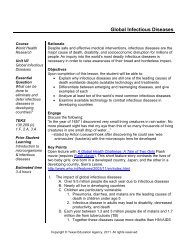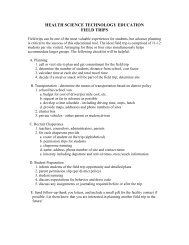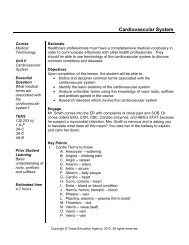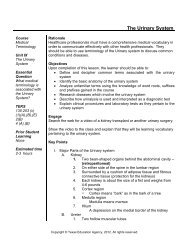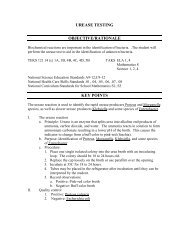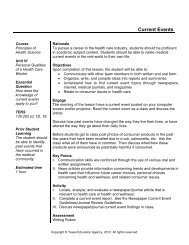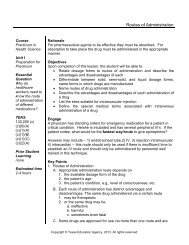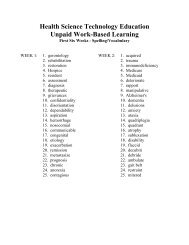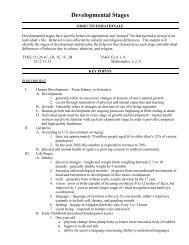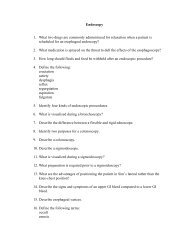Info - Dissociative Disorders.pdf - haspi
Info - Dissociative Disorders.pdf - haspi
Info - Dissociative Disorders.pdf - haspi
You also want an ePaper? Increase the reach of your titles
YUMPU automatically turns print PDFs into web optimized ePapers that Google loves.
<strong>Dissociative</strong> <strong>Disorders</strong><br />
OBJECTIVES/RATIONALE<br />
<strong>Dissociative</strong> disorders involve the dissociation, or disunity, of components of the personality that are<br />
normally integrated. As a result, some psychological function—identity, memory, control over motor<br />
behavior—is screened out of consciousness. The student will identify dissociative syndromes and<br />
characteristics of each.<br />
TEKS: 121.26 (c) 1H, 1I, 2C TAKS ELA 1, 2, 3, 4, 5, 6<br />
Science 2<br />
POWER POINT<br />
KEY POINTS<br />
I. General Description:<br />
a. rare disorders in which there is confusion or inability of individual to recall who or where<br />
they are, or how they got there<br />
b. onset could be sudden or gradual<br />
c. condition could be transient or chronic<br />
II. <strong>Dissociative</strong> disorders are traumatizing to families as well as to the person involved due to<br />
profound and unpredictable nature of these disorders.<br />
III. Types of <strong>Dissociative</strong> <strong>Disorders</strong>:<br />
a. <strong>Dissociative</strong> Amnesia.<br />
1. inability to recall important personal information<br />
2. repressed information is usually of a stressful or traumatic nature (child<br />
abuse, etc.)<br />
3. recovery of lost memories<br />
a. use of hypnosis, free association, or thiopental<br />
b. controversy among health professionals as to validity of “recovered”<br />
memories<br />
b. <strong>Dissociative</strong> Fugue.<br />
1. mental state that results in person suddenly and unexpectedly traveling to new<br />
location and assuming a new identify<br />
2. individual is unable to recall his/her former identity<br />
3. as fugue state passes, person resumes his/her former identity<br />
a. there is no recollection of interim fugue identity<br />
4. fugue state may be long or short, but generally, spontaneously remits and<br />
rarely recurs<br />
5. rare disorder that occurs mostly in men<br />
c. <strong>Dissociative</strong> Identity Disorder (Multiple Personality Disorder).<br />
1. patient manifests two or more distinct, complexly interwoven personalities,<br />
each of which is usually identified by a unique name<br />
2. different personalities alternate dominating and controlling individual and<br />
exhibit varying degrees of amnesia for the existence and mental “well being”<br />
of other personalities
3. ninety percent of patients with dissociative identity disorder have history of<br />
childhood physical and/or sexual abuse<br />
a. psychoanalytic theory: multiple personalities may develop in order to<br />
dissociate traumatic memories and drives<br />
4. symptoms often appear in adolescence and run long fluctuating course<br />
5. treatment mainly consists of extended psychotherapy with aim of merging<br />
different personalities into unified personality<br />
d. Depersonalization Disorder.<br />
1. condition in which person experiences periods of unreality about who he/she<br />
is or a sense of detachment about various aspects of his/her body<br />
2. person may seem removed, as though observing from a distance<br />
3. disorder may occur at times of traumatic events<br />
4. twice as common in men that women and rarely occurs in people over 40<br />
years of age<br />
5. about 50% of cases may become chronic<br />
ACTIVITIES<br />
I. Read and write a report on the novel The Three Faces of Eve utilizing Grading Criteria Form.<br />
II. Read and discuss <strong>Dissociative</strong> Fugue Case History.<br />
<strong>Dissociative</strong> Fugue Case History<br />
MATERIALS NEEDED<br />
http://www.amazon.com - (site on The Three Faces of Eve)<br />
http://www.healthsci.utas.edu.au/psychiatry/diss_fugue.htm – (additional case study for dissociative<br />
fugue.)<br />
http://www.healthsci.utas.edu.au/psychiatry/diss_ident_dis.htm – (case study for dissociative identity<br />
disorder)<br />
Diagnostic and Statistical Manual of Mental <strong>Disorders</strong>—Fourth Edition (DSM-IV)<br />
Grading Criteria Form for The Three Faces of Eve.<br />
ASSESSMENT<br />
ACCOMMODATIONS<br />
For reinforcement, the student will read and outline two case studies on dissociative disorder symptoms.<br />
(See on-line sites under MATERIALS NEEDED)<br />
For enrichment, the student will view and evaluate the video Sybil.<br />
REFLECTIONS
Written Report Grading Criteria Form<br />
The Three Faces of Eve<br />
Student:<br />
Date:<br />
Period:<br />
Scoring Criteria<br />
Points Earned<br />
Clear introduction paragraph that states theme of book 20 points __________<br />
Events presented in logical, coherent sequence 25 points __________<br />
Use of action verbs 10 points __________<br />
Correct grammar/spelling 15 points __________<br />
(no abbreviations or symbols)<br />
Paper is neat and legible 10 points __________<br />
Closing paragraph summarizes report 20 points __________<br />
__________<br />
TOTAL
Case History: <strong>Dissociative</strong> Fugue<br />
John Doe<br />
When the man first walked into the homeless shelter, he hadn’t a thing to his name, including a<br />
name. He’d been referred from a local hospital’s emergency room, but he told the clinician on duty that<br />
he’d only gone there for a place to stay. As far as he was aware, his physical health was good. His<br />
problem was that he didn’t remember a thing about his life prior to waking up on a park bench at dawn<br />
that morning. Later, when filling out the paperwork, the clinician had penciled in “John Doe” as the<br />
patient’s name.<br />
Aside from the fact that he could give a history spanning only about eight hours, John Doe’s<br />
mental status exam was remarkably normal. He appeared to be in his early 40s. He was dressed casually<br />
in slacks, a pink dress shirt, and a nicely fitting corduroy sports jacket with leather patches on the elbows.<br />
His speech was clear and coherent; his affect was generally pleasant, though he was obviously troubled at<br />
his loss of memory. He denied having hallucinations or delusions (“as far as I know”), though he pointed<br />
out logically enough that he “couldn’t vouch for what kind of crazy ideas I might have had yesterday.”<br />
John Doe appeared intelligent, and his fund of information was good. He could name five recent<br />
presidents in order, and he could discuss recent national and international events. He could repeat eight<br />
digits forward and six backwards. He scored 29 out of 30 on the Mini-Mental State Exam, failing only to<br />
identify the county in which the shelter was located. Although he surmised (he wore a wedding ring) that<br />
he must be married, after half an hour’s conversation he could remember nothing pertaining to his family,<br />
occupation, place of residence, or personal identity.<br />
“Let me look inside your sports jacket,” the clinician said.<br />
John Doe looked perplexed, but unbuttoned his jacket and held it open. The label gave the name<br />
of a men’s clothing store in Cincinnati, some 500 miles away.<br />
“Let’s try there,” suggested the clinician. Several telephone calls later, the Cincinnati Police<br />
Department identified John Doe as an attorney whose wife had reported him missing two days earlier.<br />
The following morning John Doe was on a bus for hone, but it was several days before the<br />
clinician heard the rest of the story. A 43-year-old specialist in wills and probate, John Doe had been<br />
accused of co-mingling the accounts of clients with his own. He had protested his innocence and hired<br />
his own attorney, but the Ohio State Bar Association stood ready to proceed against him. The pressure to<br />
straighten out his books, maintain his law practice, and defend himself in court and against his own state<br />
bar had been enormous. Two days before he disappeared, he had told his wife, “I don’t know if I can take<br />
much more of this without losing my mind.”<br />
Evaluation of John Doe<br />
Although John Doe’s case is not quite a classical example of <strong>Dissociative</strong> Fugue (he did not<br />
assume a new identity and adopt a new life), his confusion about his identity is more typical of this<br />
diagnosis. He did travel far from home and purposefully set about trying to seek shelter.<br />
Conscious imitation of amnesia in Malingering can be very difficult to discern from the amnesia<br />
involved in <strong>Dissociative</strong> Fugue. However, although John Doe did have legal difficulties, these would not<br />
have been relieved by his feigning amnesia.<br />
Case study from DSM-IV Made Easy, James Morrison, M.D.



